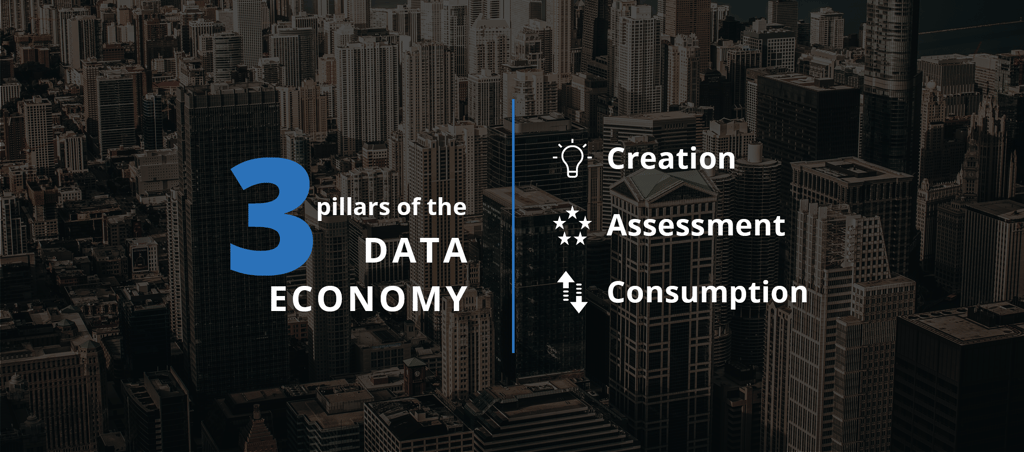Our industry continues to see an ongoing upsurge in data volumes. This comes with the insatiable need by industry leading companies to exploit existing data to foster business development and growth. We can see the data economy expanding as the many barriers that hinder and impede its progress are torn down.

At DataStreamX, we classify the ecosystem enablers into three major pillars, namely creation, assessment, and consumption. All of these are equally important and are critical to enabling a liquid data economy. In this regard, if you’re interested in partaking of the data gold mine that will drive innovation and business profits, then it’s important for you to learn how each enabler of the big data ecosystem is employed such that they provide you with insights on where your work and investments will obtain the most gain.
While building the platform and architecture of the big data infrastructure at DataStreamX and while helping our clients launch their data products, I have learned and gained insights on what works and what does not. In this series, I’ll take you through what I think the future of the data economy is.
In this article, I will discuss the trends that will drive the data product creation process. I will give a rundown of the considerations that will shape the data products of the future.
Customers’ problems come first
Most technically inclined users, such as data scientists, engineers, and architects, prefer to interact with the raw data, as they know how to import, transform, visualize, and combine it with other data sources. However, most customers do not have this capability. The data products presented to them may not be what they want.
In this regard, the best data products are the ones that the users need. This means that in the process of creating the product, the customers’ problems must be considered first before the data. Determining exactly what the customer’s problems are and how the data can solve these issues goes a long way in defining the foundation of the product.
Simple data is best
Most users cannot consume all the data they have access to nor should they be given more than what they need. In this regard, industry leading companies will be using data to build a basic product that addresses a specific customer need. End users should be provided with usable data products that can solve their problem and not what the product creators want them to have.
As technologists, we are quick to develop solutions, which we are uncertain will work. What leading companies in the data economy do is they break down the solution into smaller modules that they can use to build an MVP (Minimum Viable Product). They then determine what data they need to expand it. They do not think of all the possible data they can add to the solution, which end users don’t need, nor do they spend a lot of man hours working on the product before launching it.
It is best to create a simple product that can grow more complex over time. Starting with a complex product can make it impossible to later modify and adjust it to the customers’ needs.
Data supports business strategies
Industry leading companies often change their business strategies to adapt to environmental changes. This means that the various teams in the company can be tasked to focus on different customers and products over time. This leads to changes and inconsistencies in the data that the company receives as input or that it generates internally.
In this regard, the strategy team will increasingly need to promptly communicate the company’s long-term vision to the data team to ensure that the volume, velocity, veracity, and variety of the data in its products are aligned with the company’s vision. It is imperative for the data team to have complete visibility of the company’s technology and business strategy to ensure that the data products they create are well-structured, consistent, and scalable in the long term.
Quality data leads to long-term profitability
One of the biggest challenges of working with data is transforming it into a usable form. Overlooking the data engineering process of cleaning the data and trying to build the product right away will only lead to failure.
Data economy leaders ensure that they use high-quality data in building their products. They use assessment tools and regularly evaluate the quality to ensure that it does not degrade. Taking the time to first clean the data will go a long way in ensuring that the data product remains high quality over time. This way, new products won’t have to be created whenever the data quality decreases.
Automation ensures scalability and profitability
Companies are short on data science resources. As such, the manual and daily extraction of data products become unprofitable. To succeed, industry leading companies are able to continue generating revenue with minimal effort. They automate the data packaging and ETL (Extract, Transform, Load) processes and deliver data products to users on a regular basis without the need for human intervention. This allows them to easily scale from 1 to however many clients they want.
Moving forward
Companies at the top of the data economy are those that focus on the use cases of their data products. If organizations do not have the internal capability or experience in building sticky data products, then working with external vendors or partners will help them create and optimize these.
With all vendors working together, the data economy will become more vibrant and efficient, especially with network effects scaling through the value chain. As an added bonus, this increases the value of various businesses’ data monetization efforts.
To learn more about how you can be a part of this growing data economy, schedule a call with our data consulting team.
In my next article, I shall discuss the next enabler of the data economy, which is data assessment. This will cover the challenges that data buyers encounter when using third-party data.

